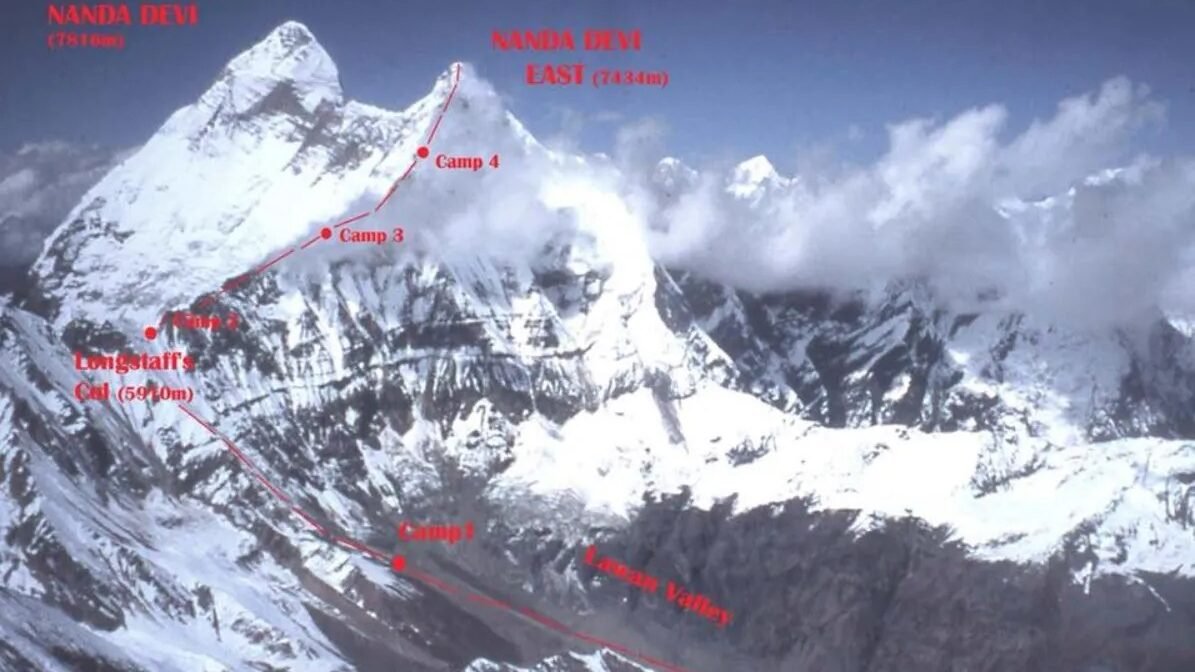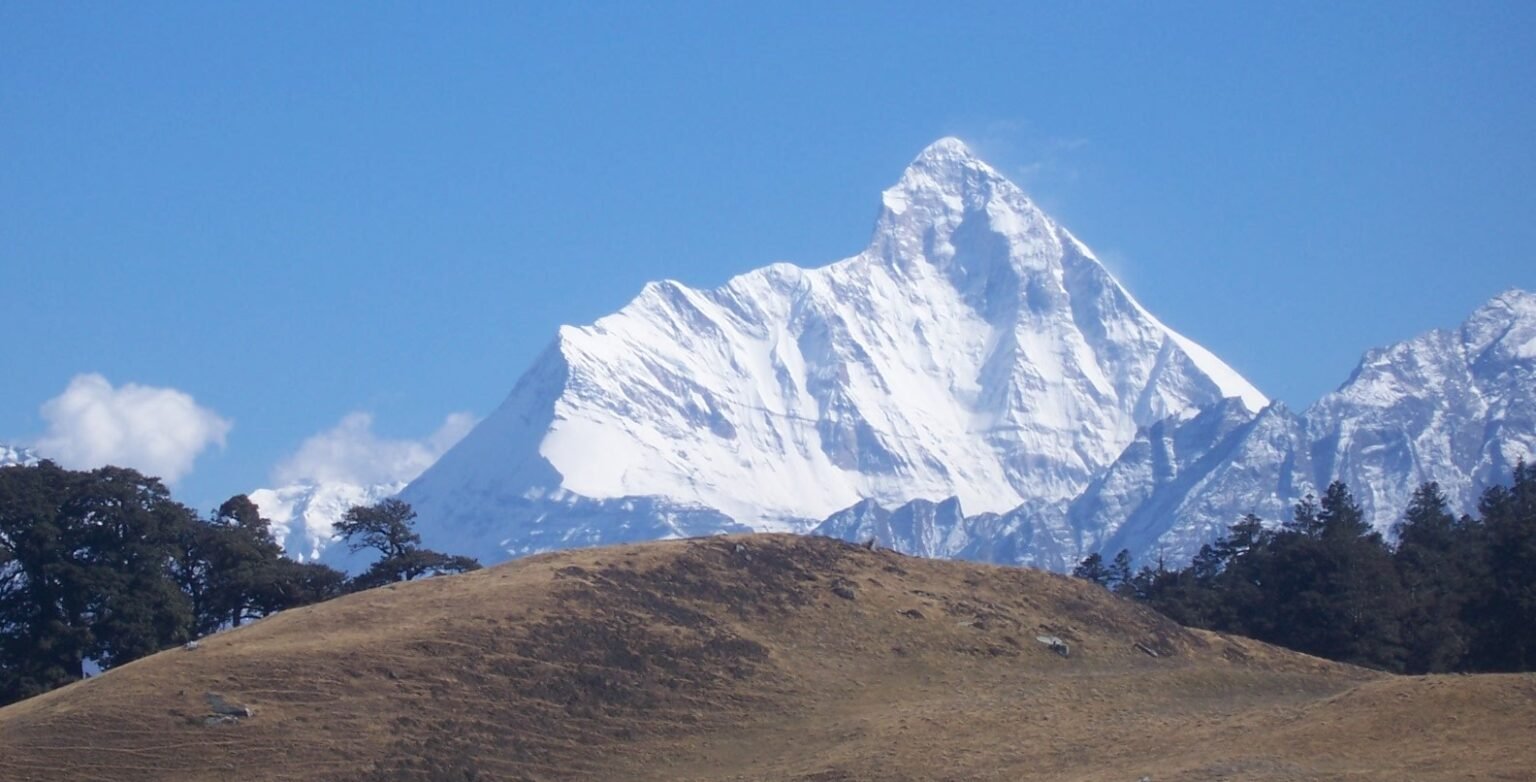Nanda Devi stands proud as the highest mountain located entirely within India, reaching an awe-inspiring 7,816 meters (25,643 feet) in the Chamoli district of Uttarakhand. More than just a peak, it is both a cultural icon and a natural wonder, revered as a living goddess, ringed by legends, and encircled by one of the world’s most unspoiled habitats.
Location and Magnitude
It towers above the Kumaon Himalayas, situated between the Rishiganga Valley on the west and the Goriganga Valley on the east in northern Uttarakhand. It forms a twin-peaked massif: the higher western Nanda Devi, and the eastern peak known as Nanda Devi East or Sunanda Devi. Surrounding the mountain is the Nanda Devi Sanctuary, a glacial basin protected by formidable ridges and accessible only through the treacherous Rishi Ganga Gorge.
- Height: 7,816 meters (25,643 ft)
- Location: Chamoli district, Uttarakhand, India
- Coordinates: 30°22′33″N 79°58′15″E
- Range: Kumaon Himalayas, Garhwal region
Key Details:
Notes:
- It is a challenging trekking/climbing destination: only experienced trekkers/climbers should attempt the advanced routes.
- Prices are for Indian nationals. Costs for foreign nationals and private expeditions are higher and may vary depending on the season and agency.
- The National Park is an ecologically sensitive zone, allowing only limited guided groups with strict regulations.
Mythology, Culture, and Spiritual Significance
For centuries, it has been much more than a mountain. She is worshipped as the “Bliss-Giving Goddess,” believed to be a manifestation of Parvati, the consort of Lord Shiva. In local lore, Princess Nanda fled to the mountains to escape a demon, finding eternal sanctuary on this pristine peak.
- Patron goddess of the region: Especially Garhwal and Kumaon
- Integral to festivals: The Nanda Devi Raj Jat Yatra, a pilgrimage covering nearly 280 km, celebrates her journey and divinity
- Cultural presence: Songs, dances, and rituals are dedicated to the goddess, making her a symbol of unity, resilience, and purity for local communities.
Historical Climbing Expeditions
It remained unconquered and mysterious for many years, drawing explorers who were captivated by both my beauty and isolation.
- 1883: First recorded attempt at entry to the Sanctuary by W.W. Graham, which failed.
- 1934: British explorers Eric Shipton and H.W. Tilman, with Nepali Sherpas, first navigated the Rishi Ganga Gorge into the Sanctuary, considered an extraordinary feat.
- 1936: Successful summit by a British-American team (Bill Tilman and Noel Odell), establishing Nanda Devi as the highest climbed peak until 1950.
- 1939: The Polish team first scaled Nanda Devi East (Sunanda Devi).
Climbing it has always been considered a test of skill, endurance, and respect; the remoteness and steep rise above the deep valleys make it one of the world’s most challenging and most beautiful mountains.
Protected Wilderness: The Nanda Devi National Park
The area surrounding it is among the most ecologically important and beautiful landscapes in India. The Nanda Devi Sanctuary is ringed by high peaks and is a pristine wilderness.
- 1982: Area declared a National Park, later extended as part of UNESCO’s World Heritage Site (also includes the Valley of Flowers).
- National Park: 2,236.74 km² core area, 5,148.57 km² buffer.
- Flora and fauna: Alpine forests, rare flowers, Himalayan musk deer, snow leopards, and countless endemic species.
The park and inner sanctuary were closed to all climbers, including locals, in 1983 to preserve their fragile ecosystem, reflecting the region’s sacred attitude toward the mountain and its ecosystem.
Climate and Environmental Influence
- Climate: Harsh, alpine climate above 3,500 m; perpetual snow and glaciers dominate the upper reaches.
- Influence: Glacial melt from it feeds headstreams of the Ganges, sustaining millions.
- Seasons: The Best time for visitors is May to October, when the valleys are lush and the snow recedes from the lower trails.
Trekking Around Nanda Devi
Trekking in the Nanda Devi region offers a profound mix of adventure and spirituality:
National Park Trek
- Start: Lata Village near Joshimath.
- Route: Lata → Lata Kharak → Semi Kharak → Dharansi Pass.
- Difficulty: Moderate to challenging; for experienced trekkers.
- Permit: Strictly regulated; only guided treks with permits allowed.
- Highlight: The trek passes through dense forests, river valleys, and alpine meadows, offering uninterrupted views of Nanda Devi and the surrounding peaks.
Base Camp Trek (Sunanda Devi/East)
- Start: Munsyari in the Kumaon Himalaya.
- Experience: Wild forests, rivers, and untouched tribal villages, culminating at the eastern base, from where both Nanda Devi and Sunanda Devi are visible.
- Altitude: Base camp at ~4000 m; trek passes diverse terrain and cultural sites.
Valley of Flowers Link
- The Valley of Flowers, another UNESCO World Heritage site, is accessible via a separate trail but is part of the same biosphere reserve. Combined “twin-trek” itineraries are possible with some advance planning.
Tourist Attractions and Local Culture
- Major towns: Joshimath and Munsyari (gateways for trekkers).
- Temples: The Nanda Devi Temple in Almora is a revered site, serving as the focus for the annual Nanda Devi Mahotsav.
- Fairs: The Nanda Devi Raj Jat Yatra and associated fairs are once-in-a-lifetime cultural experiences that involve music, dance, rituals, and a journey through some of the Himalayas’ wildest territory.

Environmental Preservation and Recent Changes
- The region has strict environmental protections, allowing only limited trekking, and access to the inner sanctuary remains highly restricted to protect both spirituality and biodiversity.
- In recent years, access rules have been occasionally revised, with the outer Sanctuary and select trekking routes reopening for regulated visits.
Nanda Devi in Indian and Global Imagination
It is more than the sum of her physical attributes. The mountain features prominently in literature, films, travelogues, and spiritual journeys, symbolising mystery, strength, and India’s living connection with the natural world.
2025 Trekking Season: New Rules and Responsible Adventure
This year, authorities have eased permit restrictions, facilitating access to select trekking routes for responsible adventurers. Renewed interest in the region’s spiritual and ecological richness is attracting more visitors while preserving the sacredness and biodiversity that are central to Nanda Devi’s identity. Local guides, eco-friendly practices, and cultural immersion are now at the heart of trekking experiences, ensuring that every visit honours both the goddess and the environment.
It continues to shine as a summit of faith, natural grandeur, and responsible travel, inviting the world to witness her timeless splendour while safeguarding her fragile beauty for generations to come.
FAQs About Nanda Devi Mountain
What is the height of Nanda Devi?
It towers at 7,816 meters (25,643 ft), making it the highest mountain entirely within India and the second-highest in the country.
Where is Nanda Devi located?
It is situated in the Chamoli district of Uttarakhand, between the Rishiganga and Goriganga valleys, within the Kumaon Himalayas.
Why is Nanda Devi considered sacred?
Nanda Devi is worshipped as the “Bliss-Giving Goddess” and a form of Parvati in Hinduism, central to religious festivals and local traditions in Uttarakhand.
Can tourists or trekkers visit Nanda Devi?
Yes, but access is limited and regulated to protect the ecosystem. Permits are needed, and only approved routes in the outer Sanctuary and National Park are open for trekking. The inner Sanctuary remains mostly closed.
What is the best season to trek to Nanda Devi?
Trekking is best from May to October, when snow retreats from lower altitudes and wildflowers and mountain vistas are at their peak.
What wildlife can be found in Nanda Devi National Park?
The region is home to the Himalayan musk deer, snow leopards, bharal (also known as blue sheep), Himalayan tahr, and a vast array of endemic alpine plants and birds.
What is the Nanda Devi Raj Jat Yatra?
This is a grand pilgrimage undertaken every 12 years, covering about 280 km in honour of the goddess Nanda Devi, retracing her mythical journey to her mountain home.
Are there any significant historical climbs?
Yes, notably the first summit in 1936 by Bill Tilman and Noel Odell, a landmark in mountaineering history, and the first ascent of Nanda Devi East by a Polish team in 1939.
